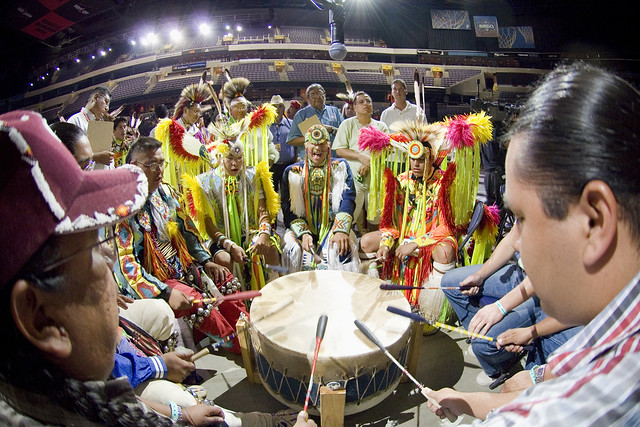Tuning Native Drums
If your drum tone sounds flat and dull then it needs tuning, before we go into the "How to Tune" part, let's discuss factors that affect rawhide. Rawhide by its nature shrinks or expands depending on certain conditions. In cold, moist and humid weather or these types of environments rawhide expands. In hot and dry weather or when exposed to a heat source rawhide shrinks.
 |
| Photo by Smithsonian Institution |
Warning! Over exposing your drum to heat can lead to permanent damage. Please re-read that again, because whatever heat source you use it's important to know this. So don't place your drum in front or next to a heat source and walk away and forget about it. Ok, now that we have got that out of the way let us look at some different methods we can use to heat our drum which causes the rawhide to shrink and gives us a better tune/tone from our drum .
.
Methods to tune your Drum
- Hair dryer - the quickest and easiest way to tune a drum. Start in the centre of the drum and work your way towards the edges. Should only take a few minutes.
- Heat lamp - Place the drum in front of the heat lamp, once again should only take a few minutes. Periodically play your drum to test the tone.
- Heater or fire place- Using this method it's important not to place the drum too close to the heat. If it's too hot for your hand then you need to move the drum further away.
- Campfire - The preferred method of Native Indians to tune their drums. Most of us have seen the image of Native Indians dancing around the fire beating on their drums. Just make sure you do not place your drum too close to the naked flames.
Each of the above methods works well, just make sure you do not over do it. By that I mean, leave the drum in front or too close to the heat source for too long. If you do, over time the rawhide will become over stretched and eventually lose its natural elastic quality.
Also, if you over do it the rawhide can shrink too much and damage the timber frame of the drum. Regardless of the method you use, test the tune of the drum as you go through the process by playing the drum until you are happy with the tone. Providing it's done correctly you can repeatedly use these methods without affecting the life span of the drum.
So far we have talked about ways to tune your drum if it sounds flat and dull. What if you have the opposite problem? On a hot dry day the drum may sound very high pitched; in this case, the best way to get the rawhide to loosen is by spraying or sprinkling small amounts of water on the rawhide.
Start from the edges of the drum and work your way to the middle. Let it rest for a few minutes then test the tone of the drum. Keep repeating until you have the desired tone. Avoid wetting the timber frame of the drum and just like the heating method don't over do it. In fact, use this method if you do over heat your drum to loosen the rawhide.
Other factors that affect the tune and tone of Native American Drums .
.
Besides environmental conditions, there are other factors that affect the tone and pitch of Native Indian drums. They are:
- Size of the drum. Generally the larger the drum size, that includes the rawhide surface area, timber frame width and depth, the deeper the tone and more the tone resonates. Small drums tend to have a more sharp higher pitch. Although other factors come into effect which can affect the tune, tone and pitch, regardless of the size.
- Rawhide thickness. In my experience rawhide thickness has the biggest effect on the tone of drums, particularly "Hoop Drums". The thicker the hide the deeper the tone and pitch. Thinner hides have a higher sharp pitch. So you can have a large drum with a thin hide which produces a high sharp pitch tune or a smaller drum with a thick hide that producers a deep long tune.
These are all important factors you need to take into consideration when selecting your drum.
Native Drums in Australia
Southwest Trading Post is the direct importers of authentic Native Drums into Australia. All our drums go through the appropriate quarantine procedures when entering the country.
If you have any questions please contact us through our website http://www.southwesttraders.com.au/.
Article Source: EzineArticles
|

No comments:
Post a Comment